Learn how to cook garbanzo beans that are soft, creamy, and full of flavor. Discover the best techniques for soaking and cooking to get the best flavor and texture (without the beans bursting).
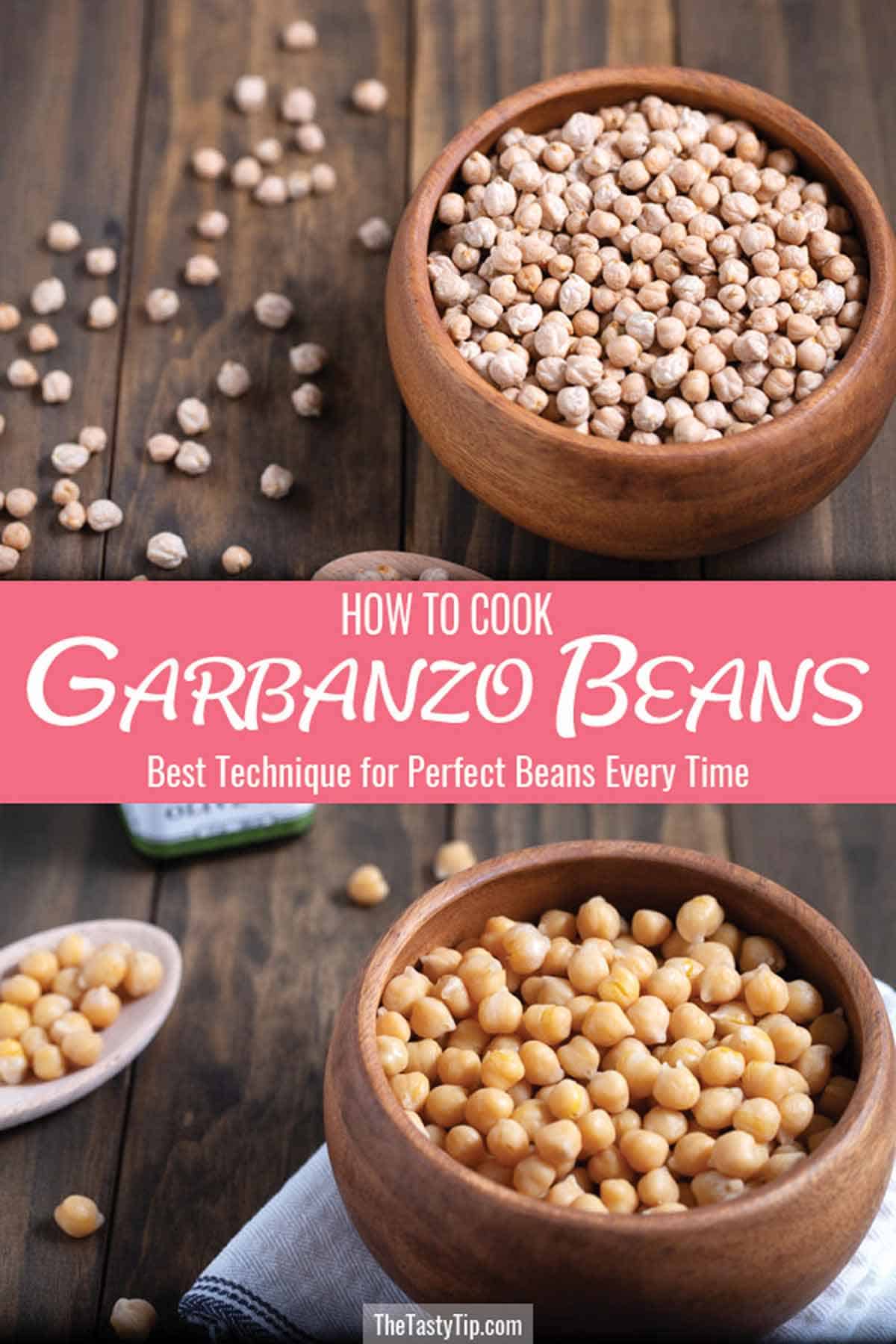
Just to clear the air: garbanzo beans and chickpeas are the same beans. Historically, the Spanish used garbanzo and the English coined the term chickpea. Both names are used today.
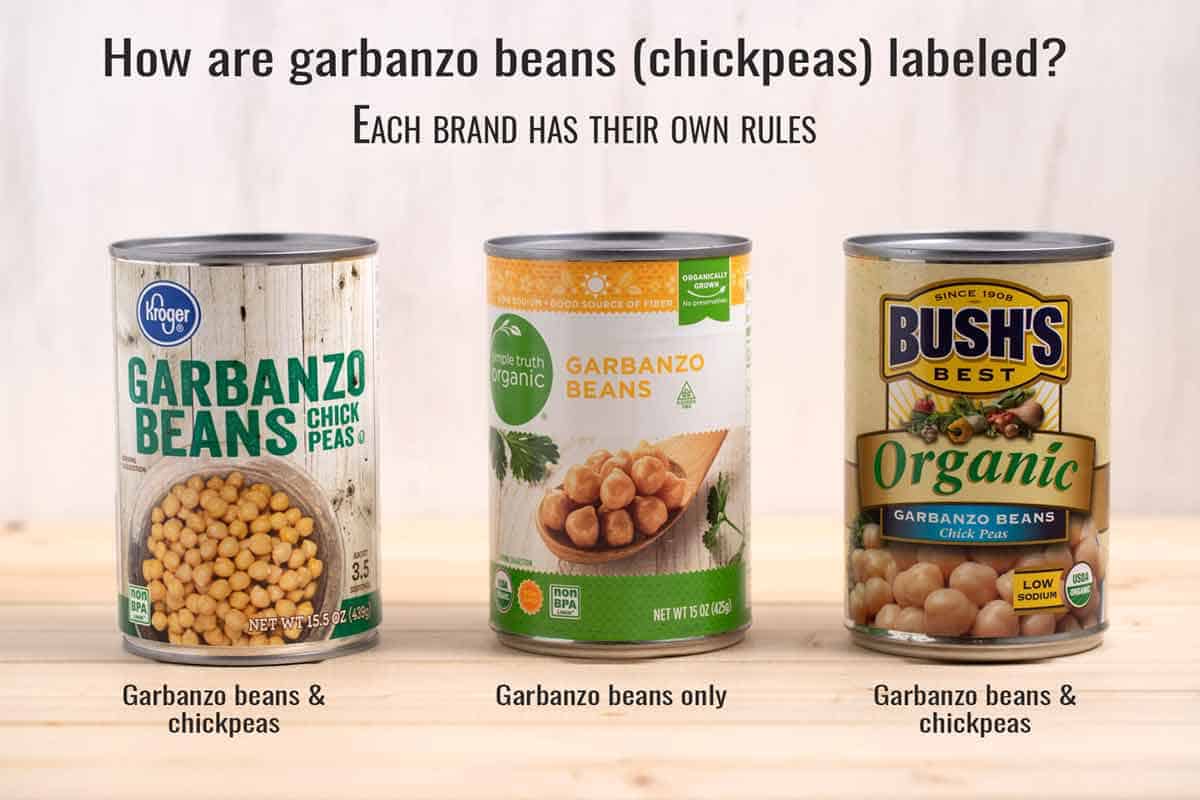
In the United States the names are used interchangeably. In fact, it’s easy to find cans labeled garbanzo beans and cans marked chickpeas in grocery stores side by side. Some brands even have both bean names on the label.
All beans taste better when they are home-cooked. But what is the best cooking method?
In this tutorial, I'll show my experiments in soak solution and cooking method. I found that soaking in salt water gives the best flavor and texture. But slow cooker, Instant Pot, and stove all have benefits.
RELATED: Check out my post on how to cook black beans if you are interested in cooking black beans from scratch.
Jump to:
- Why You Will Love to Cook Garbanzo Beans from Scratch
- Do You Really Need to Soak Garbanzo Beans Before Cooking?
- How to Soak Garbanzo Beans
- The Soak Test (Experiment #1)
- What is the Science Behind Soaking Beans in Salt Water?
- The Best Technique to Soak Garbanzo Beans
- The Cooking Method Test (Experiment #2)
- The Cooking Liquid Test (Experiment #3)
- Best Cooking Process for Garbanzo Beans
- Instant Pot Garbanzo Beans/Chickpeas
- How to Cook Garbanzo Beans in an Electric Pressure Cooker (after pre-soaking in salt water overnight)
- How to Cook Garbanzo Beans in a Slow Cooker (after pre-soaking in salt water overnight)
- How to Cook Garbanzo Beans on the Stove Top (after pre-soaking in salt water overnight)
- How do You Know When Garbanzo Beans are Done?
- What is the Quick Soak Method?
- What is Aquafaba?
- Frequently Asked Questions
- What do Chickpeas Taste Like?
- How to Store Chickpeas (Garbanzo Beans)
- How Long do Cooked Garbanzo Beans Last in the Fridge
- Can you Freeze Garbanzo Beans?
- How to Cook Frozen Chickpeas
- Recipe
- What to Make with Garbanzo Beans
- Comments
Why You Will Love to Cook Garbanzo Beans from Scratch
- Save money: Dry beans always cost less than canned beans. Buy them prepackaged or from the bulk bin in the grocery store.
- Get a better taste: Home-cooked garbanzo beans taste fresher and better than canned beans.
- Chemical-free: Never worry about BPA or other chemicals often found in tin cans when you cook beans from scratch.
Do You Really Need to Soak Garbanzo Beans Before Cooking?
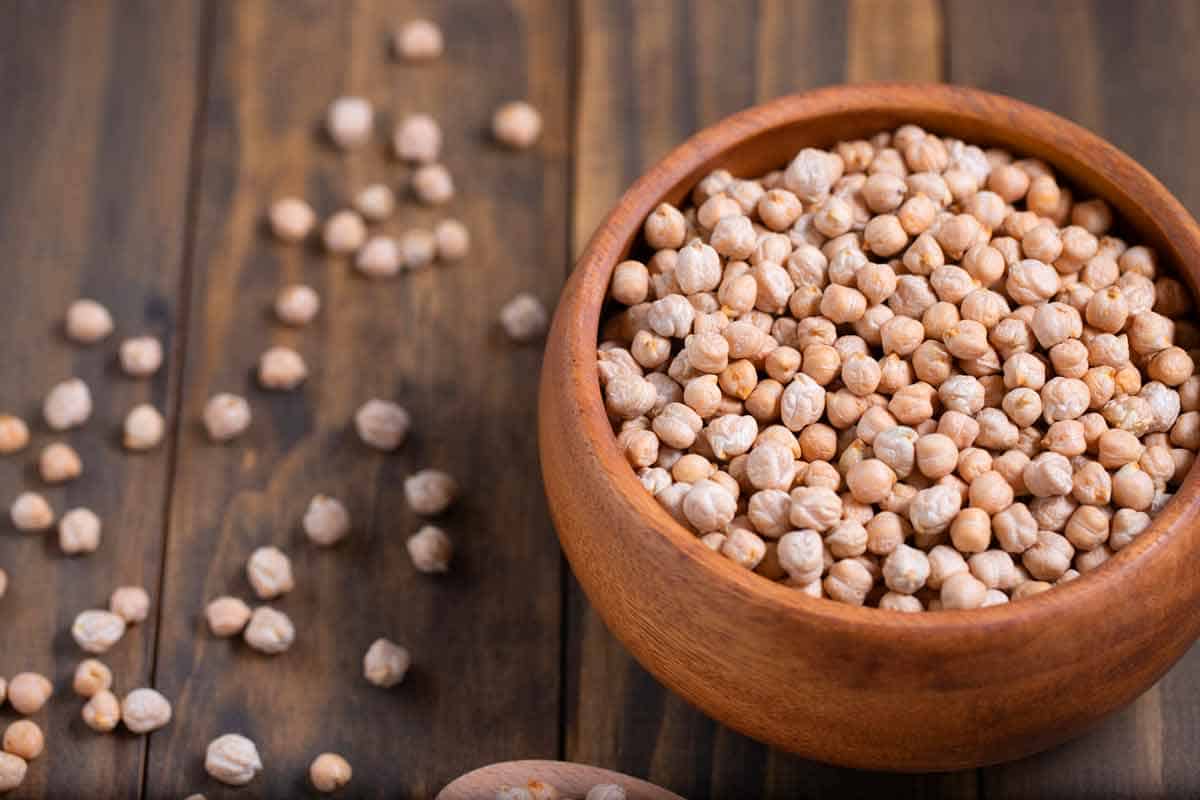
You may ask this question if you are pressed for time. I always recommend pre-soaking dried beans. Soak the beans in plenty of water for at least 8 hours, but preferably overnight (10-12 hours).
Why should you soak beans before cooking them?
- Reduced cooking time. Soaking beans reduces the cooking time by about 30%.
- Better texture. Presoaking makes creamier and softer beans.
- Reduced gastrointestinal symptoms. Soaking garbanzo beans can help reduce bloating and flatulence often associated with eating beans.
Garbanzo beans contain complex sugars known as oligosaccharides. Unfortunately, our digestive enzymes cannot break down oligosaccharides. As a result, the bacteria in our intestines ferment these complex sugars, causing gas and bloating.
However, oligosaccharides are water-soluble. This means if you soak the beans, discard the soak water, and thoroughly rinse them, you can wash away a lot of these complex sugars.
Always discard the soak water the next day and get fresh water to cook the beans.
How to Soak Garbanzo Beans
Soaked beans take less time to cook.
However, everyone has an opinion about what solution to soak the beans in. Some chefs advocate salt water, while others tout the benefits of a baking soda and water solution.
And then there is just plain water. That was what I had been using for a long time.
I firmly believe that technique is one of the most essential elements of good cooking. After reading conflicting views on the best way to soak garbanzo beans, I conducted my own experiment. I called it The Soak Test.
The Soak Test (Experiment #1)
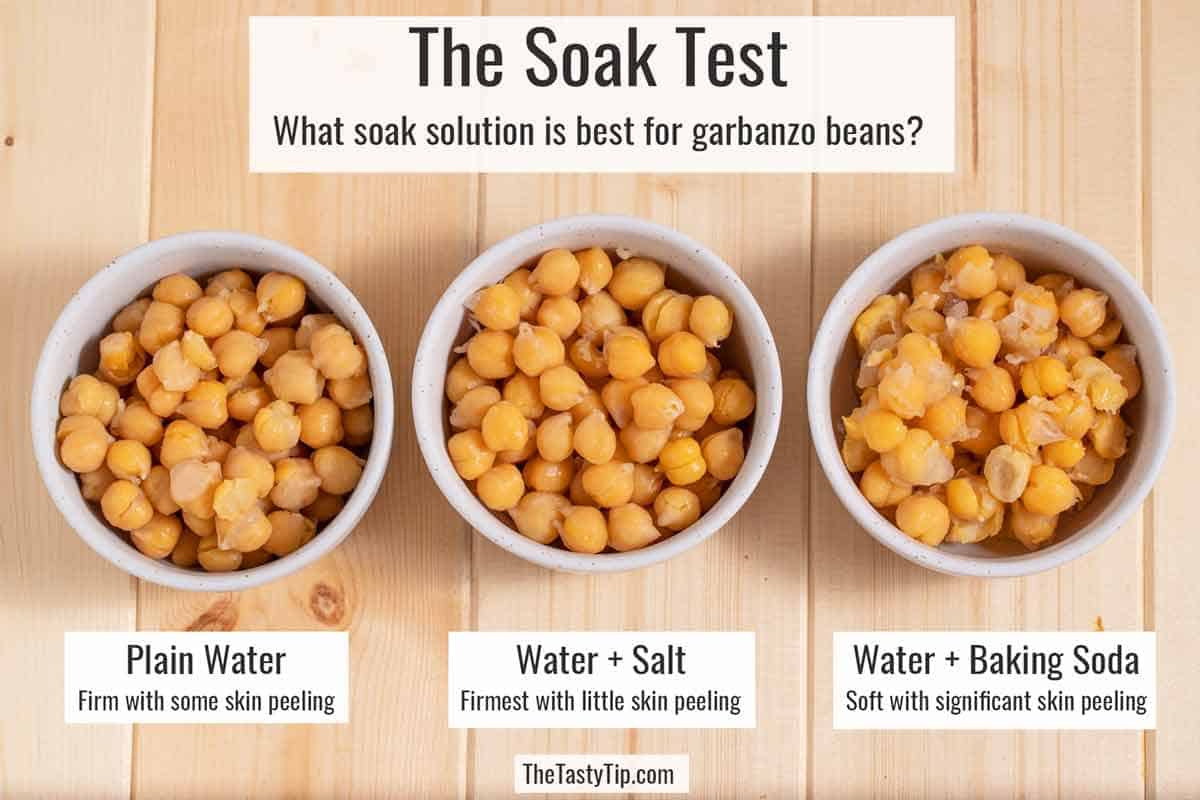
Question: What is the difference in garbanzo beans' appearance, texture, and taste based on the solution they are soaked in.
For each soak, I used 8 cups of cold water and 1 cup of dried garbanzo beans. This ratio gives the beans enough water to soak and expand.
Soak Solutions:
- Plain water (control group): 8 cups of plain water
- Salt water: 8 cups of water + 1½ tablespoons of granulated salt
- Water with baking soda: 8 cups of water + ⅛ teaspoon of baking soda
Results
| Soak Water | Texture | Skin Peeling |
|---|---|---|
| Plain water | Firm | Some peeling |
| Salt water | Firmest | No peeling |
| Baking soda water | Soft | Significant peeling |
Appearance: I observed each set of beans after being soaked overnight and then cooked.
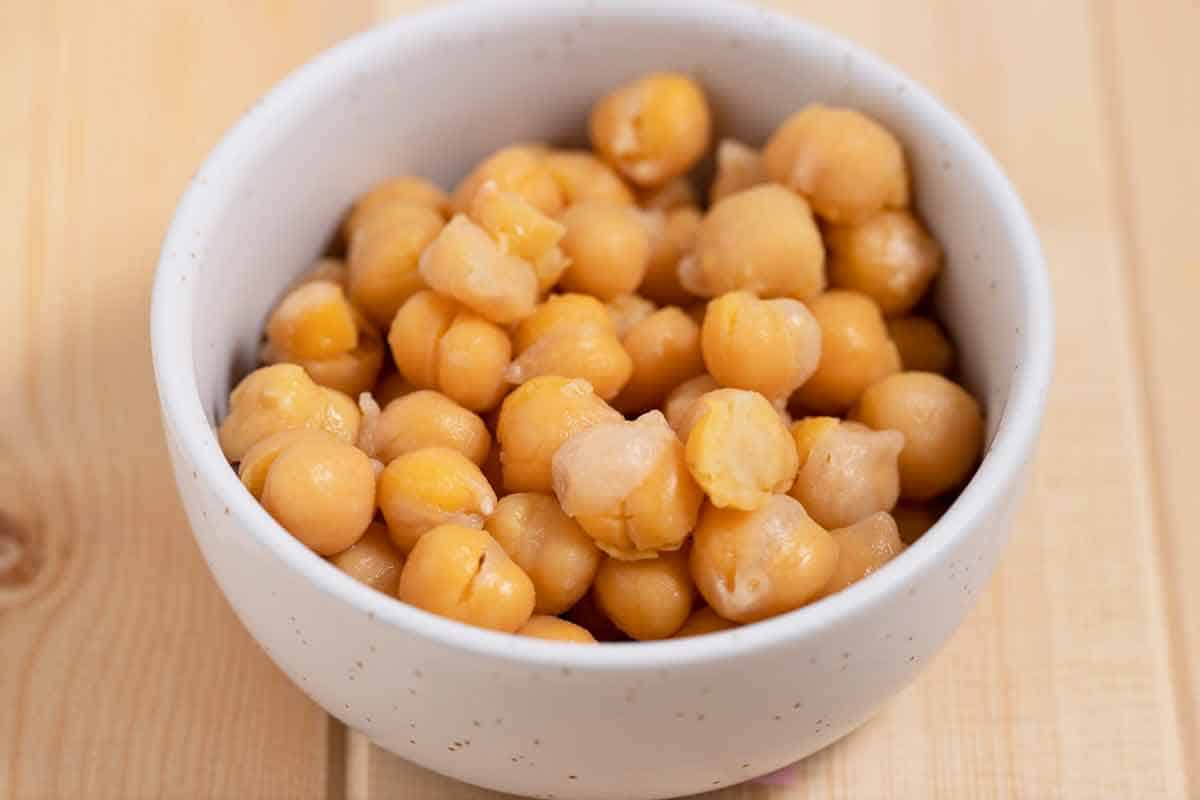
- Garbanzo beans soaked in plain water (control group): The beans appeared firm, with some skin peeling.
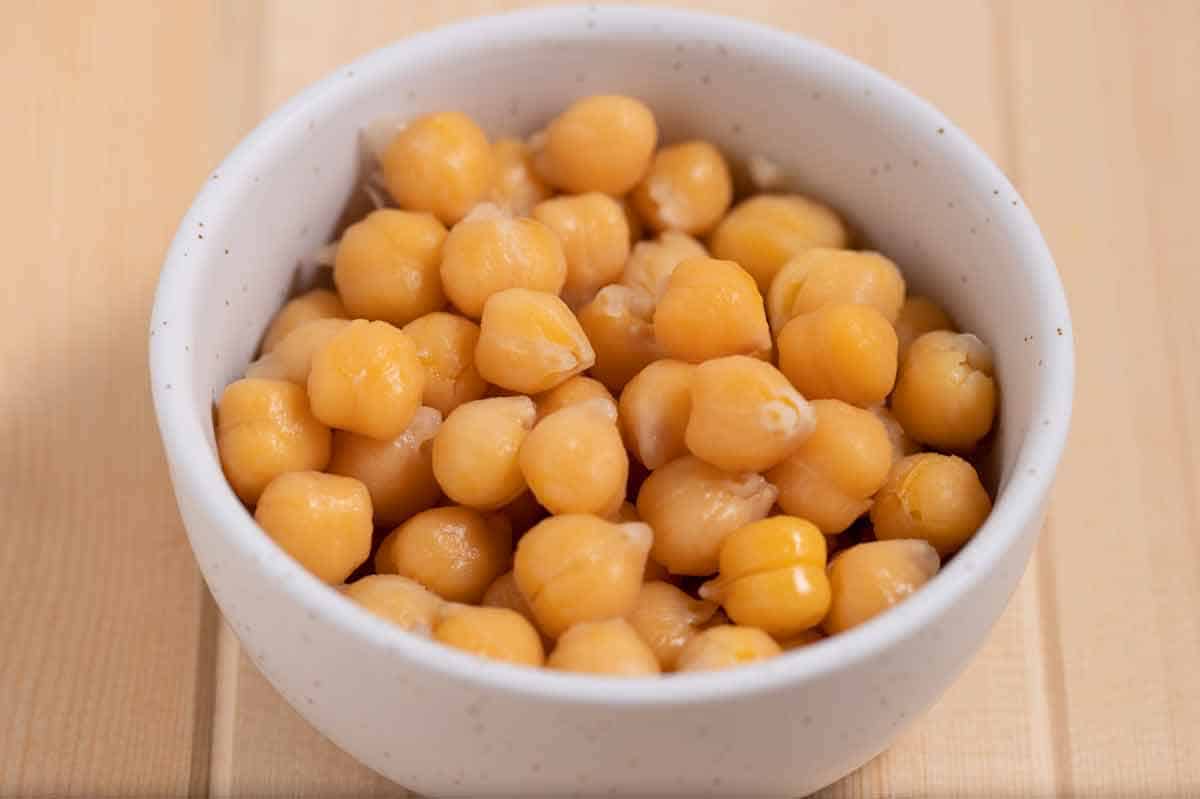
- Garbanzo beans soaked in salt water: These beans looked the firmest, with little or no skin peeling off.
If you plan to roast the garbanzo beans or use them in a salad, I recommend soaking them in salt water brine.
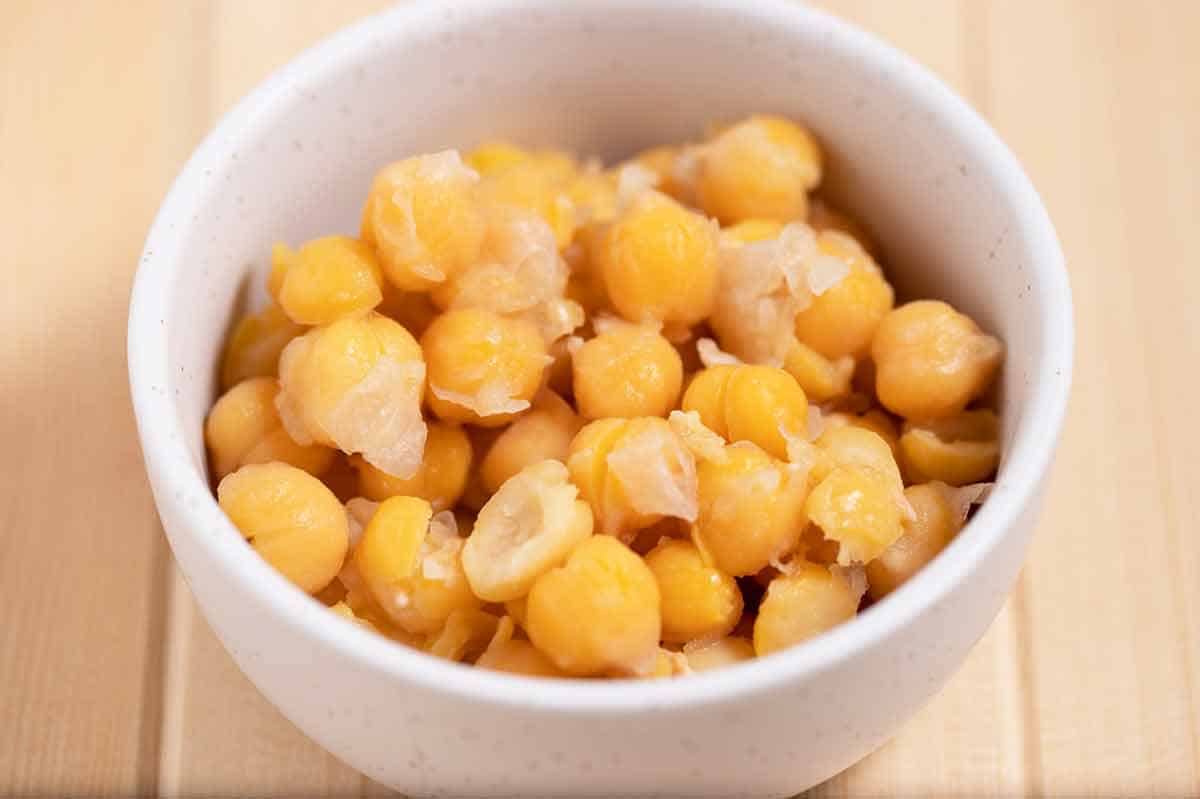
- Garbanzo beans soaked in water and baking soda: The bean skin fell off easily. Some skins were even floating in the water.
If you like to peel the skin off your garbanzo beans before making hummus, soak your beans in a baking soda and water solution.
Texture and Feel: I mashed a bean from each group between my fingers to feel the texture and softness of each bean.
- Garbanzo beans soaked in plain water (control group): Beans were soft but held their shape.
- Garbanzo beans soaked in salt water brine: These beans were the firmest. The appearance and texture were consistent. Firm all around.
- Garbanzo beans soaked in water and baking soda: These beans were the softest, perhaps even overdone. They may not need as much cooking time after soaking with baking soda.
Taste: I recruited the family tasters to sample and evaluate each bean group.
- Garbanzo beans soaked in plain water (control group): They tasted fine – no problems.
- Garbanzo beans soaked in salt water brine: These were all of our favorites. They did not taste salty, but the bean tasted better.
What surprised me the most was that the inside of the bean was creamy. It looked like it was the firmest of the three groups and was the firmest when smashed between my fingers.
However, the inside defied my expectations based on appearance. It was rich and smooth.
- Garbanzo beans soaked in water and baking soda: Unanimous vote for least favorite. It was hard to get past the mushiness. And they tasted bland.
What is the Science Behind Soaking Beans in Salt Water?
The answer involves chemistry.
Remember learning about ions and ion exchanges in high school chemistry? Me neither.
But as I researched why soaking beans in salt water produced such excellent results, I stumbled on a chemistry lesson.
Bean skins contain pectin molecules with strong calcium and magnesium ions. When beans soak in salt water, sodium ions (salt) exchange places with some of the calcium and magnesium ions.
This weakens the pectin in the skin so the bean can absorb more water. You get a bean with a softer texture.
In addition, the sodium ions allow the bean skin to be more flexible. The flexibility helps the bean skin expand as it absorbs water. During cooking, the bean skin stretches and stays intact rather than bursting.
The Best Technique to Soak Garbanzo Beans
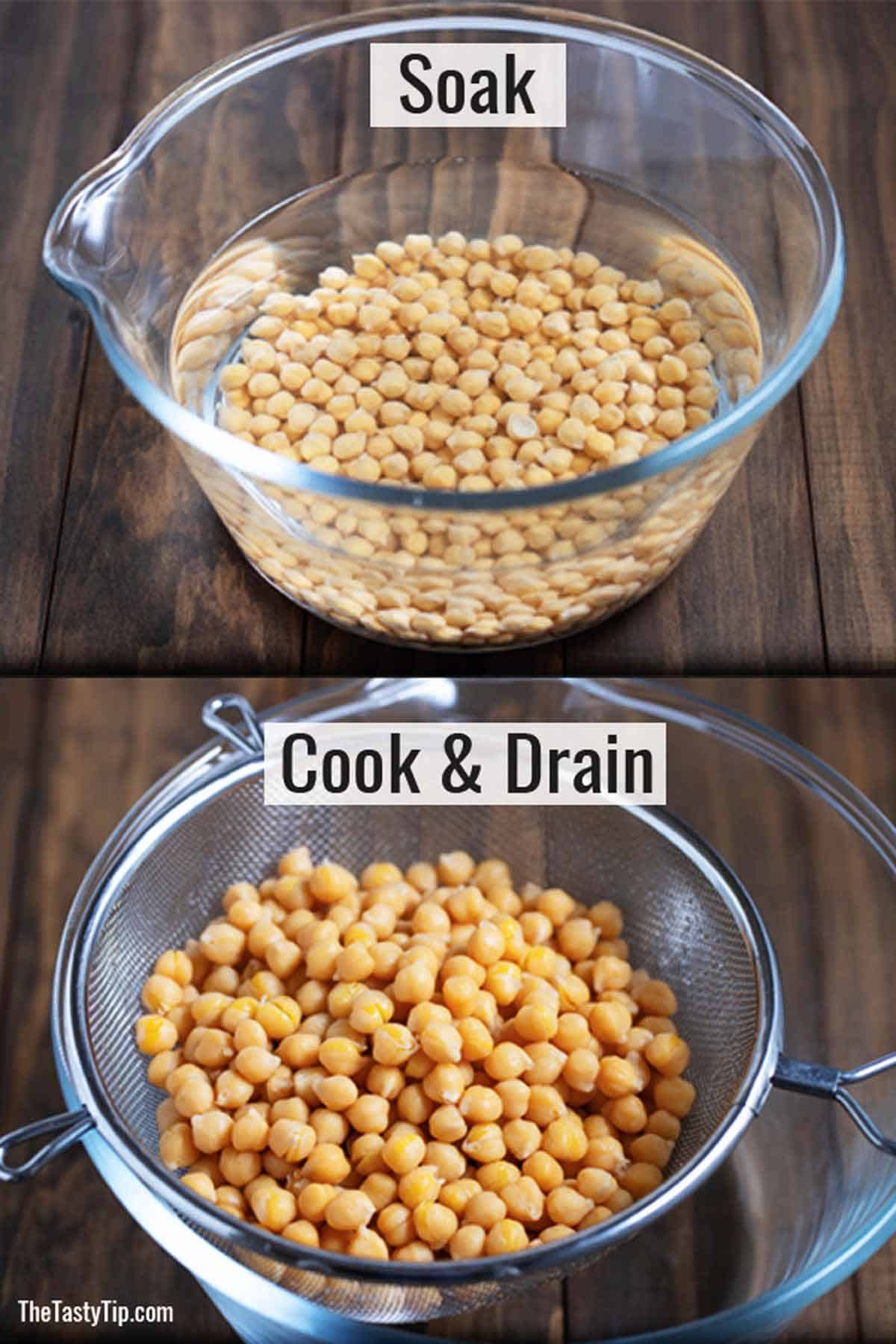
- SORT the garbanzo beans. Remove any debris.
- SOAK the beans in salt water. Place 1 cup of chickpeas in a large bowl and soak with 2 quarts water and 1½ tablespoons of salt.
Beans will soak up a lot of water, so give them enough. Soak at least 8 hours, but preferably 10-12 hours. - DRAIN and RINSE the beans. Drain the beans in a colander. Rinse them for 15 seconds under running water.
YIELD: approximately 2¼ cups of cooked beans for every 1 cup of dried garbanzo beans.
The Cooking Method Test (Experiment #2)
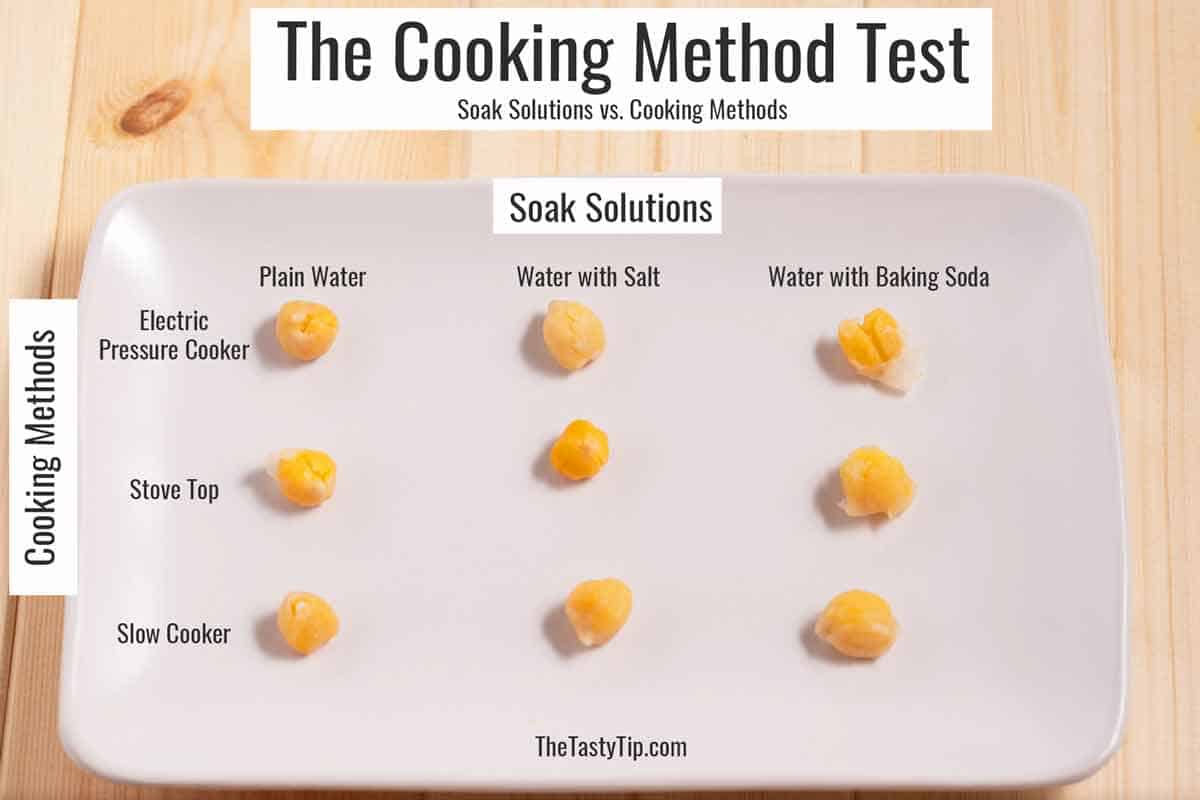
Now that you know the best soaking method, let’s move on to the ideal cooking approach.
Question: What is the difference in the taste and texture of garbanzo beans based on the cooking method used to cook the beans.
Cooking Methods
- Electric pressure cooker
- Slow cooker
- Stockpot on the stovetop
I evaluated the cooking time and ease, the texture of the cooked bean, and the taste.
Results: Time and Ease
| Cooking Method | Cook Time | Pros | Cons |
|---|---|---|---|
| Pressure Cooker | 15 minutes | quickest & easiest | can't check progress while cooking |
| Slow Cooker | 2-3 hours (high) 8-12 hours (low) | hands-free, easy to check progress | longest |
| Stovetop | 60 to 90 minutes | easy to check progress, moderate cook time | most hands-on time and attention |
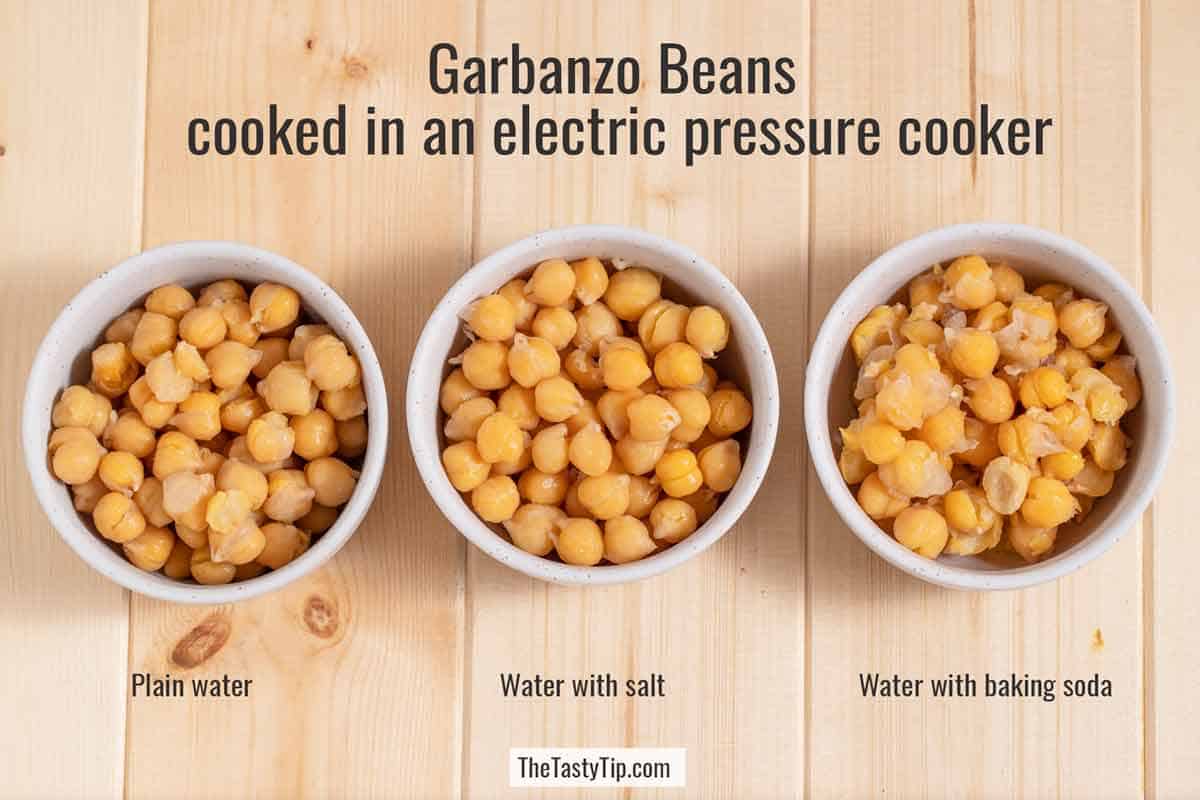
Pressure Cooker Garbanzo Beans
- Quickest method: It takes about 10 minutes to reach high pressure, followed by 15 minutes to cook. Total time = approximately 25 minutes. This does not include the time it takes the pressure cooker to naturally release pressure (about 20 minutes).
- Easiest method: Hands-free cooking. The timer indicates when the beans are finished, and the automatic warmer keeps the beans warm until you are ready to use them.
- Impossible to check during cooking: You must release pressure to check whether the beans are finished. If the beans need more cook time, pressurize the pan again. This takes a few minutes, depending on your pressure cooker and the amount of water in the pan.
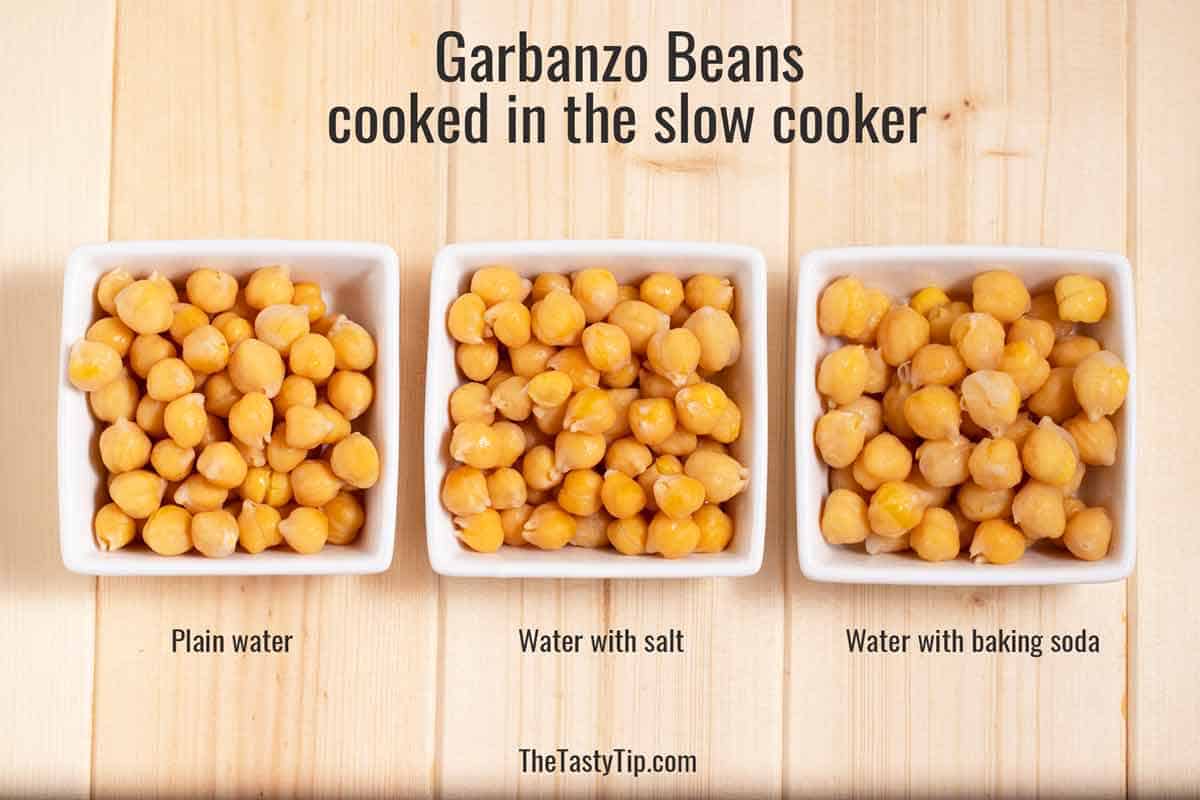
Slow Cooker Garbanzo Beans
- Longest method: It takes 2 to 3 hours to cook on high and 8 to 10 hours on low.
- Hands-free: Pour in water and beans, turn on the slow cooker, and you are done. The beans stay warm when they are finished cooking until you are ready to use them.
- Easy to check during cooking: Easy to check the beans and continue cooking if they aren’t finished.
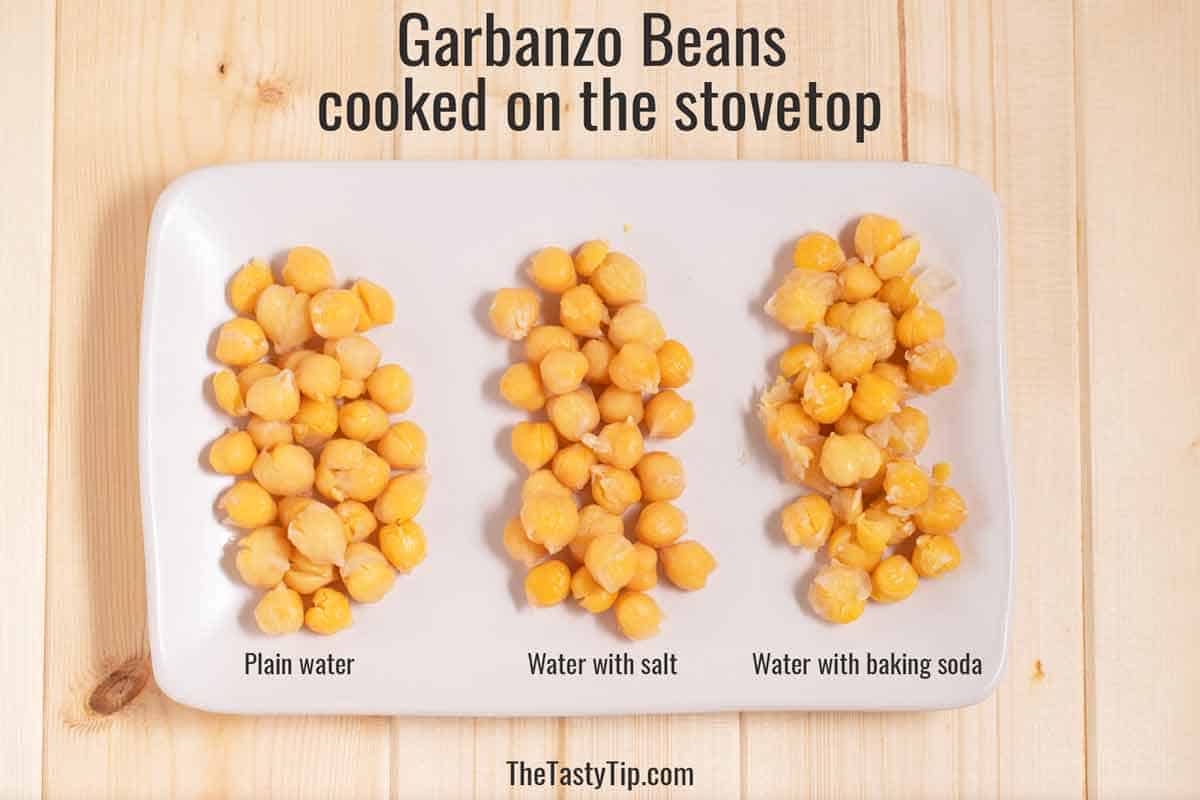
Stovetop Garbanzo Beans
- Moderate time method: It takes about an hour to cook the beans.
- Hardest method: This is not hands-free. Heat the garbanzo beans to a boil. Then reduce heat to a simmer. Simmer until the beans are finished cooking. Turn off the stove and remove the pan from heat after the beans are done.
- Easy to check during cooking: Check the beans anytime and continue cooking if they aren’t finished.
Texture
When cooking with each of these simple methods, there was no noticeable difference in the texture of the cooked beans.
The most significant factor in getting the right texture was cooking the beans for the correct amount of time for each cooking method.
As indicated above, slow cooker and stovetop garbanzo beans are easier to check for doneness than pressure cooked beans.
Taste
The flavor of the cooked beans was very similar. If forced to choose, we preferred garbanzo beans cooked in the slow cooker. They tasted slightly better (all other things being equal). But the difference in flavor was minimal at best.
Recommendations
Each of these methods produces a flavorful, excellent textured garbanzo bean. The difference comes in the ease and time each technique takes.
Therefore, I recommend the electric pressure cooker because it is the quickest and easiest hands-free method.
The Cooking Liquid Test (Experiment #3)
Question: What is the difference in taste, texture, and appearance in the garbanzo beans when cooked in salt water versus plain water.
We know soaking the beans in salt water is the best soaking method. But does cooking them in salt water make a difference as well?
Cooking Solution
- Plain water
- Salt water
I soaked 1 cup of garbanzo beans in salt water overnight. Then I cooked the beans in either 3 cups of plain water (control group) or 3 cups of water + 1 teaspoon of salt.
Results
| Cooking Liquid | Texture | Taste |
|---|---|---|
| Plain water | Identical appearance and texture | Good flavor |
| Salt water | Identical appearance and texture | Best flavor |
There was no noticeable difference in appearance and texture of the beans, regardless of whether they were cooked in plain water or salt water.
However, all the tasters preferred the taste of the garbanzo beans cooked in salt water.
Please note: the beans did not taste salty. They simply had more flavor.
Can You Cook Chickpeas in Chicken Broth?
You can boil beans in a cooking liquid other than water. Vegetable or chicken broth are both excellent choices to get flavorful chickpeas.
Make a soup with chickpeas, chicken broth, a couple of bay leaves, and lemon peel.
Best Cooking Process for Garbanzo Beans
The experiment results were clear. Soaking garbanzo beans in salt water AND cooking the beans in salt water produced the best outcome. You get the best flavored beans with an excellent appearance and texture.
All three cooking methods produced delicious beans, with negligible differences. So, choose whichever cooking method works for you. Keep in mind the pros and cons of each technique when making your choice.
Listed below are the directions for cooking the beans using each of the three methods.
Instant Pot Garbanzo Beans/Chickpeas
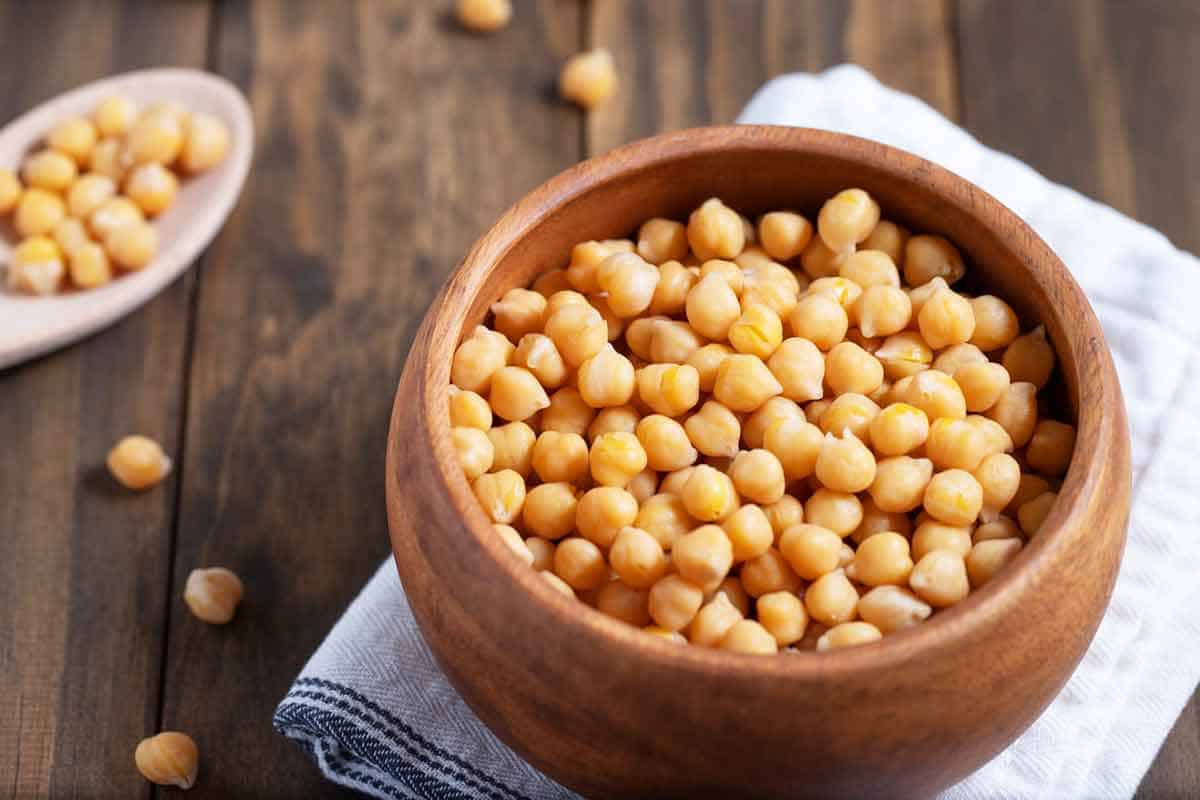
I should rephrase “instant pot garbanzo beans” to “electric pressure cooker garbanzo beans.”
The Instant Pot is the most popular electric pressure cooker out there. However, any electric pressure cooker will work. This is my favorite way to cook garbanzo beans. It is easy and takes less time to cook. Best of all, it is hands-free.
Most electric pressure cookers have a warming function. Cook the beans in the morning before work. The soft chickpeas will be warm and ready for you at night.
How to Cook Garbanzo Beans in an Electric Pressure Cooker (after pre-soaking in salt water overnight)
Instant Pot chickpeas are quick, easy, and low maintenance.
- ADD the soaked chickpeas to the pressure cooker. Pour in 1 to 2 cups of fresh water (cover the beans by 1 inch) and 1 teaspoon of salt.
- COOK on high pressure for 15 minutes.
- ALLOW NATURAL PRESSURE RELEASE when the pressure cooker has finished. Try to resist a quick release.
- SKIM the foam from off the top. DRAIN the beans.
Pro Tip: Keep the used chickpea water. You can use this bean water, known as aquafaba. More on aquafaba below.
- RINSE the beans. Use the cooked beans in any recipe.
How to Cook Garbanzo Beans in a Slow Cooker (after pre-soaking in salt water overnight)
- ADD pre-soaked beans to the slow cooker container. Cover the beans with 2 inches of water (about 4 cups of fresh water) and 1 teaspoon of salt.
- COOK on high for 2 to 3 hours or on low for 8 to 12 hours.
- SKIM off the foam on top. DRAIN the beans. Keep the aquafaba (bean water) if desired.
- RINSE the beans and use them in any recipe.
How to Cook Garbanzo Beans on the Stove Top (after pre-soaking in salt water overnight)
- ADD pre-soaked beans to a large pot. Add 4 cups of fresh water to cover beans 1 inch and 1 teaspoon of salt.
- COVER with the lid and bring the water to a rolling boil.
- REDUCE the heat to low. Keep the lid on the pan. The water should simmer but not boil over.
- SIMMER the beans for 60 to 90 minutes.
- SKIM off the foam on top. DRAIN the beans. Keep the aquafaba (bean water) if desired.
- RINSE the beans and use them in any recipe.
How do You Know When Garbanzo Beans are Done?
Garbanzo beans are done when they are soft enough to be smashed between your fingers. They will have a smooth and creamy consistency.
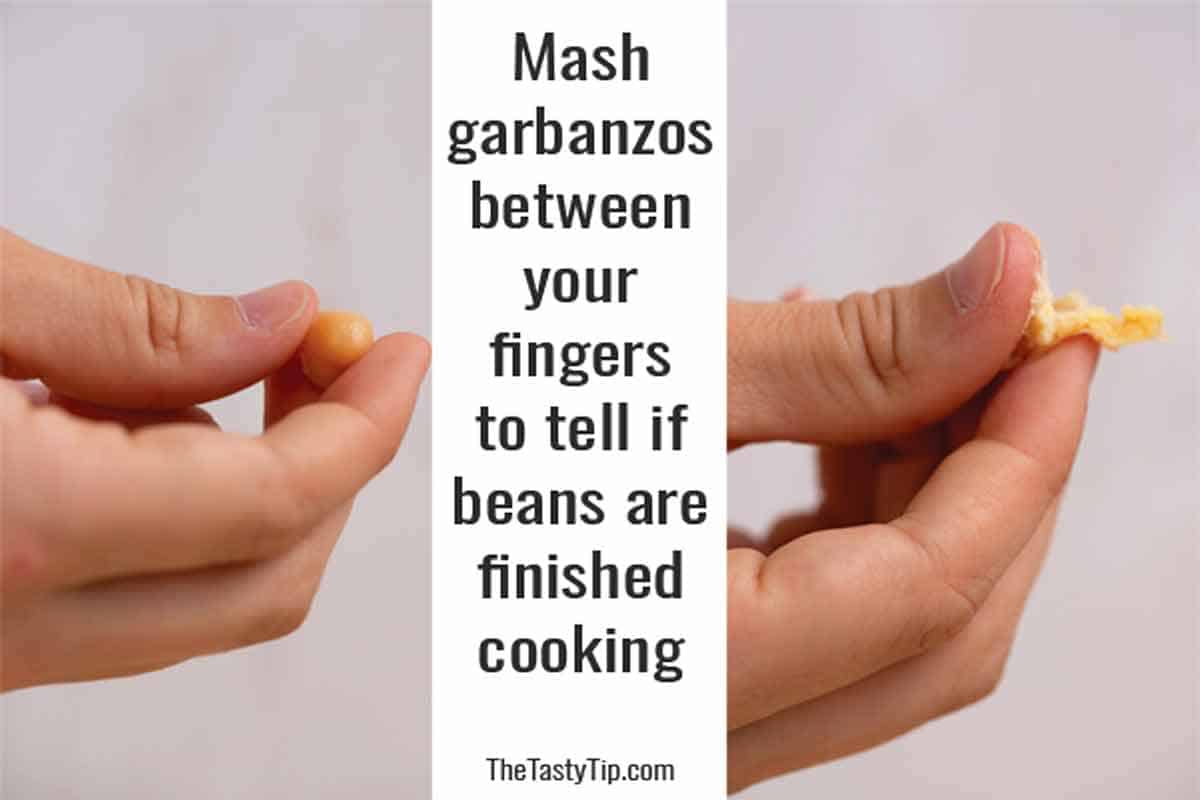
What is the Quick Soak Method?
If you forget to soak the beans overnight, all is not lost. You can follow the quick soak method instead.
What is the quick-soak method? The quick soak process is a speedy way to soften beans before cooking. Boil the beans for 3 minutes and then soak them in the hot water for an hour.
- SORT and RINSE 2 cups of beans (1 pound).
- POUR the beans, eight cups of water, and 1½ tablespoons of salt into a large pan.
- HEAT on the stovetop until the water boils.
- BOIL for 3 minutes.
- REMOVE the whole pot from the heat. Place the lid on the pan and let the beans rest in the hot water for at least an hour.
- When you are ready to cook the beans, DRAIN the water and RINSE the beans. Then COOK them using whichever cooking method you prefer.
What is Aquafaba?
Aquafaba is the water that remains after the beans have cooked. It is thick and slightly slimy. The name aquafaba literally means bean water.
Using aquafaba is a better option than throwing it out.
Aquafaba can be a fantastic egg substitute. If it is thick enough, 1 tablespoon is equivalent to one egg yolk. Two tablespoons can substitute for one egg white. Three tablespoons act like one whole egg.
Frequently Asked Questions
Garbanzo beans (chickpeas) get soft when cooked for enough time. If your beans are not soft yet, they aren’t finished cooking.
Soaking beans with either salt or baking soda can help soften beans before cooking them.
This all depends on your cooking method and whether you have pre-soaked the beans.
Pre-soaked beans + electric pressure cooker: 15 minute cook time
Pre-soaked beans + stovetop: 60 minute cook time
Pre-soaked beans + slow cooker on high: 2 to 3 hours cook time
Pre-soaked beans + slow cooker on low: 10-12 hours cook time
Older chickpeas are tougher. They need more soaking time and have a longer cook time. Soak for a couple of days, refreshing the water every 8 hours. Then cook chickpeas an additional 10 to 15 minutes in a pressure cooker and 30 minutes longer on the stove.
If your chickpeas aren’t softening, continue to cook them until they are soft. Older chickpeas/garbanzo beans take longer to cook.
The next time you cook old chickpeas, try soaking them with baking soda to soften them before cooking.
Add salt to your cooking water to enhance the flavor and help the beans cook more evenly.
One cup of dried chickpeas makes approximately 2¼ cups of cooked chickpeas.
There are approximately 120 calories in ½ cup cooked garbanzo beans.
There are approximately 7 grams of protein in ½ cup cooked garbanzo beans.
120 calories
2 g fat
0 mg cholesterol
300 mg sodium
21 g carbohydrate
4 g fiber
7 g protein
What do Chickpeas Taste Like?
Chickpeas have a mostly neutral taste with mild nutty flavor. They blend easily with other ingredients, being savory and filling. Blended, they have a slightly grainy but creamy texture.
Chickpeas are a staple in many vegan diets.
There are many excellent recipes with homemade chickpeas. Smooth hummus, hearty veggie burgers, and tangy garbanzo bean salad are a few examples of easy chickpea recipes.
How to Store Chickpeas (Garbanzo Beans)
- Store dry chickpeas in an airtight container (like a lidded mason jar) in your cupboard.
- For future use, store cooked chickpeas in the refrigerator or the freezer.
How Long do Cooked Garbanzo Beans Last in the Fridge
Cooked garbanzo beans last up to one week when stored in the refrigerator in an airtight container.
Can you Freeze Garbanzo Beans?
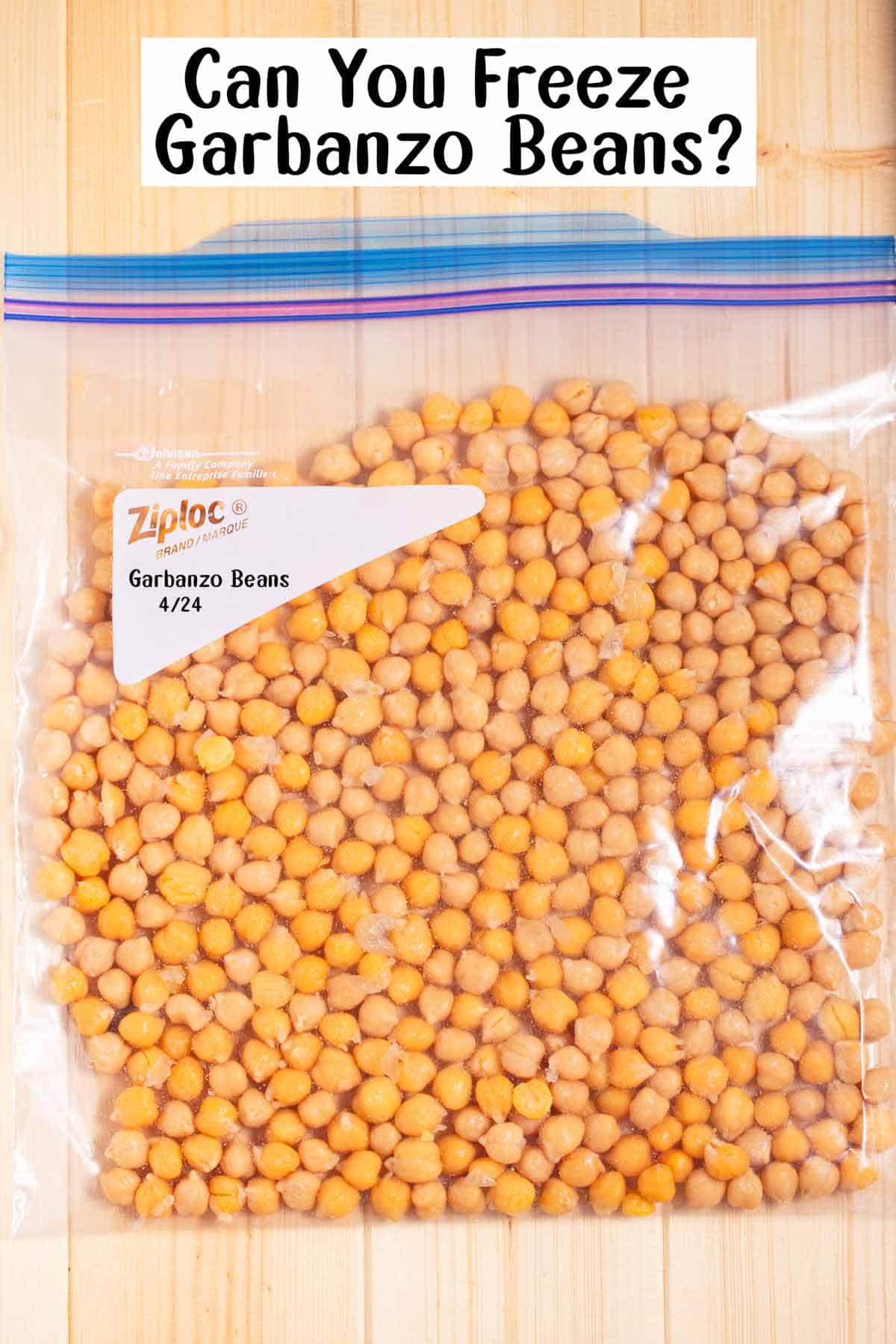
You can easily freeze garbanzo beans and have them ready whenever you need them.
- After they are cooked, drain the beans thoroughly.
- Pat them dry with a clean towel or paper towel. The beans freeze best if they are dry.
- Place the beans in a zip-top freezer bag in a single layer. Lay the bag flat in the freezer.
- Freeze one hour. Then remove the bag and shake and gently break apart any beans that froze together.
- Return to the freezer and freeze completely. Store them in the zip-top bag or a freezer-safe container.
- Store the frozen beans for up to 6 months.
How to Cook Frozen Chickpeas
To use the frozen chickpeas, pull out the amount you need and return the rest of the bag to the freezer.
Frozen chickpeas are a great addition to soups and casseroles. Do not thaw first if you are using the beans in a cooked dish. Simply mix the beans in.
Depending on the amount of frozen beans you added, you may need to increase the cooking time by 5 or 10 minutes.
If you are using the beans in a raw dish (like hummus or salad), thaw the beans in the refrigerator before using them in the recipe.
Did you like this post? Then let's be social. FOLLOW ME on INSTAGRAM and PINTEREST to keep up with the latest happenings.
Recipe
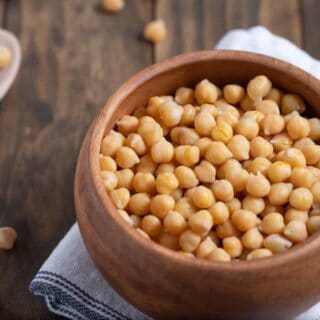
How to Cook Garbanzo Beans
Ingredients
- 1 cup of dry garbanzo beans
- 2 quarts of water 8 cups - to soak
- 1½ tablespoons of salt - for soak water
- 3 cups of water - to cook
- 1 teaspoon of salt - to cook
Instructions
Soak the Beans
- SORT the garbanzo beans. Remove any debris.
- SOAK 1 cup of beans in a bowl with 2 quarts (8 cups) of water and 1½ tablespoons of salt. Soak at least 8 hours, but preferably 10-12 hours.
- DRAIN the beans in a colander.
- RINSE the beans for 15 seconds under running water.
Pressure Cooker Instructions
- ADD beans to the pressure cooker. Pour in 1 to 2 cups of fresh water (to cover the beans by 1 inch) and 1 teaspoon of salt.
- COOK on high pressure for 15 minutes.
- NATURALLY RELEASE PRESSURE when the pressure cooker has finished.
- SKIM the foam off the top. DRAIN the beans.
- RINSE the beans. Use the cooked beans in any recipe.
Slow Cooker Instructions
- ADD pre-soaked beans to the slow cooker container. Add 3 cups of fresh water (to cover beans 1 inch) and 1 teaspoon of salt.
- COOK on high for 2 to 3 hours or on low for 8 to 12 hours.
- SKIM the foam off the top. DRAIN the beans.
- RINSE the beans and use them in any recipe.
Stovetop Instructions
- ADD pre-soaked beans to a large pot. Add 3 cups of fresh water (to cover beans) 1 inch and 1 teaspoon of salt.
- COVER with the lid and bring the water to a rolling boil.
- REDUCE the heat to low when the water begins to boil. Keep the lid on the pan. The water should simmer, but not boil over.
- SIMMER the beans for 60 minutes.
- SKIM the foam off the top. DRAIN the beans.
- RINSE the beans and use them in any recipe.
Notes
Nutrition
Did you make this recipe? Tag @thetastytip on Instagram and hashtag it #thetastytip.
What to Make with Garbanzo Beans
- Original hummus: To make hummus, blend chickpeas, water, lemon juice, olive oil, tahini, spices, and kosher salt in a food processor.
- Roasted red pepper hummus: Roasted red pepper hummus is flavored with roasted red peppers and seasoned with smoked paprika. Slightly sweet, smoky, and bright, with a hint of bitter tahini. Quick and easy appetizer or snack, high in fiber and protein.

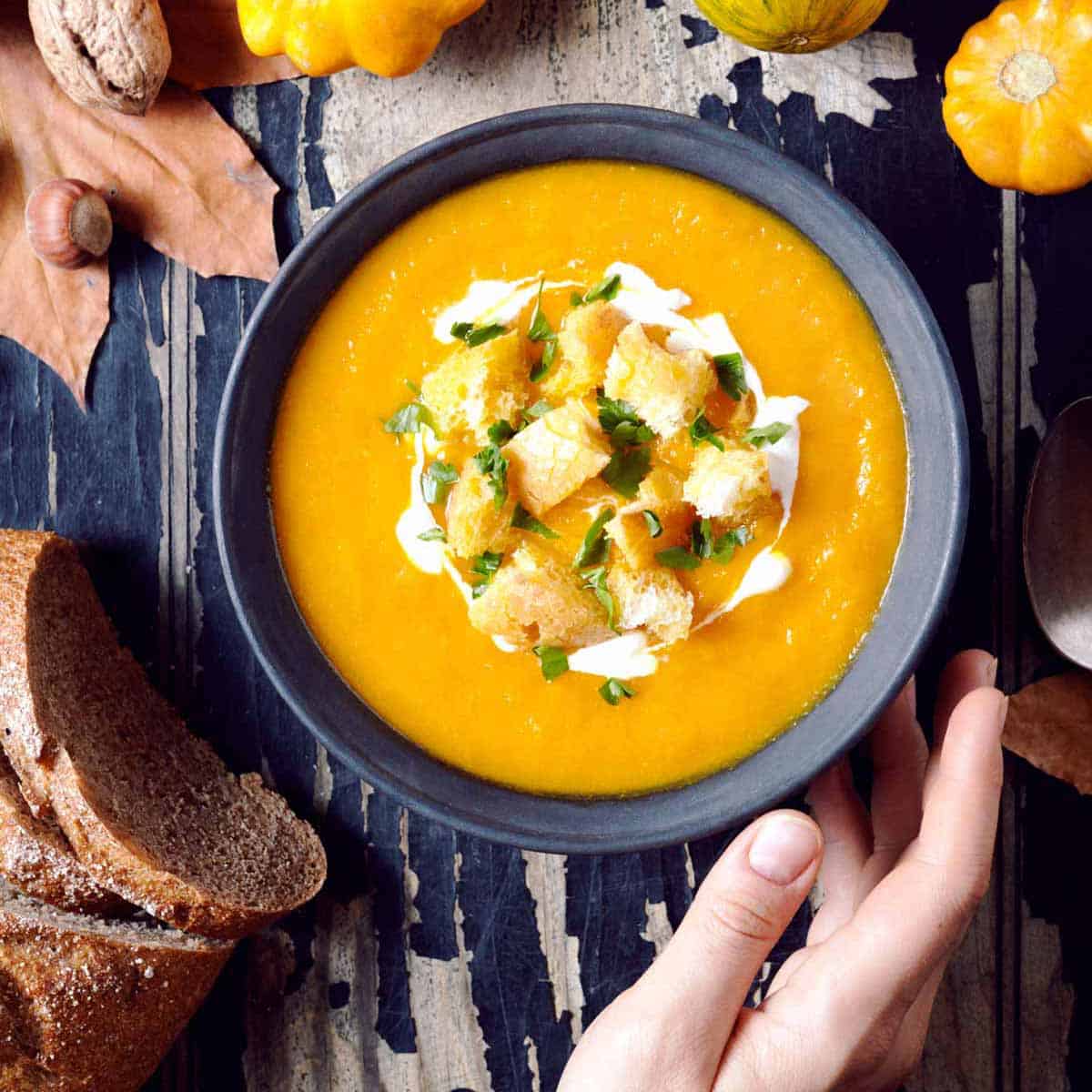
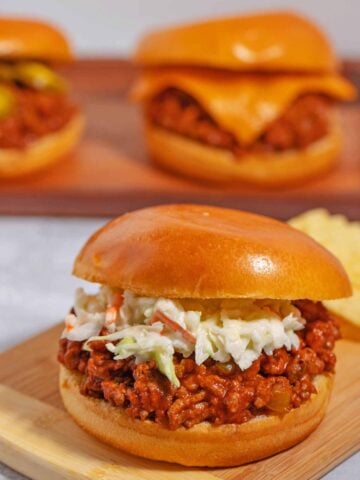
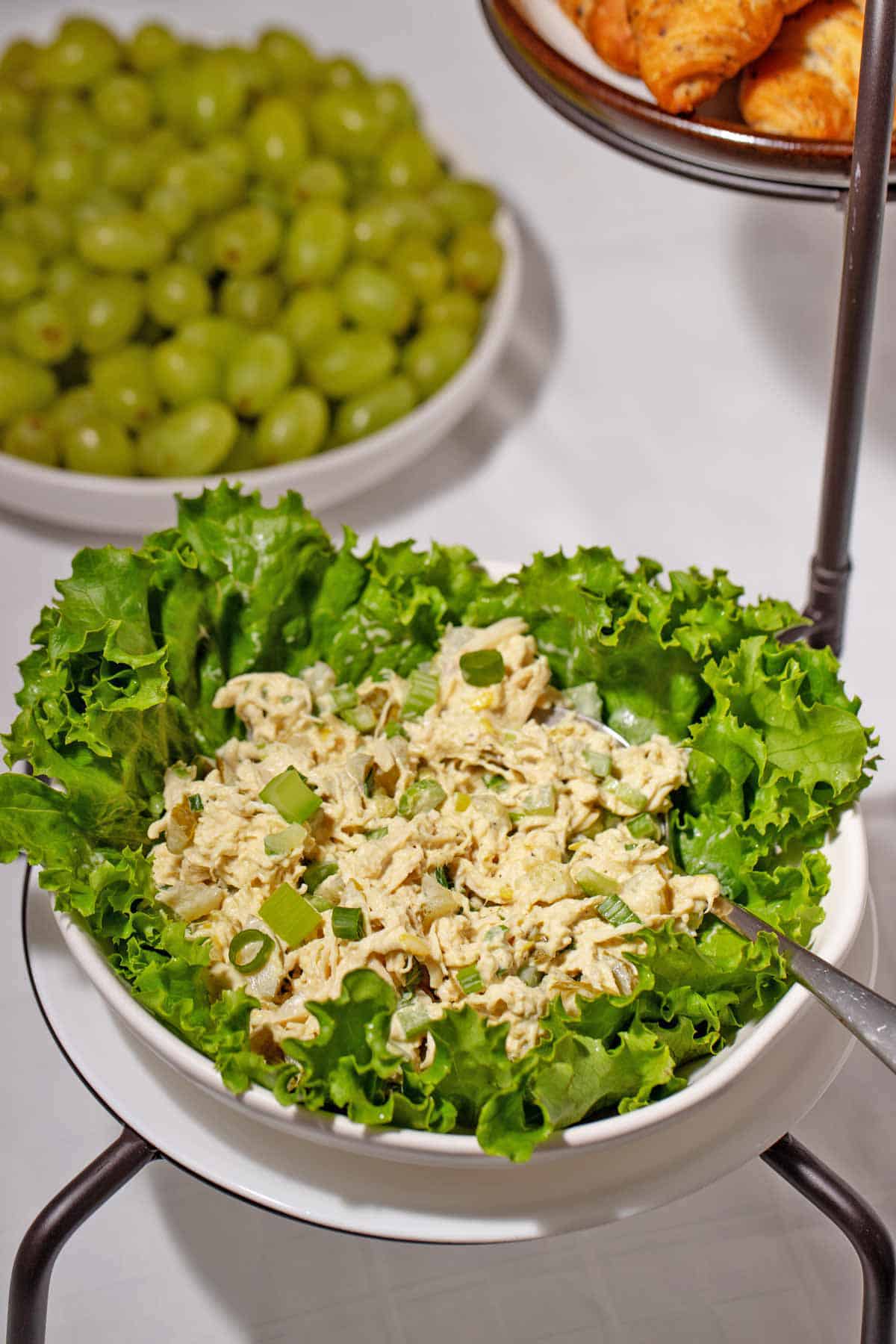
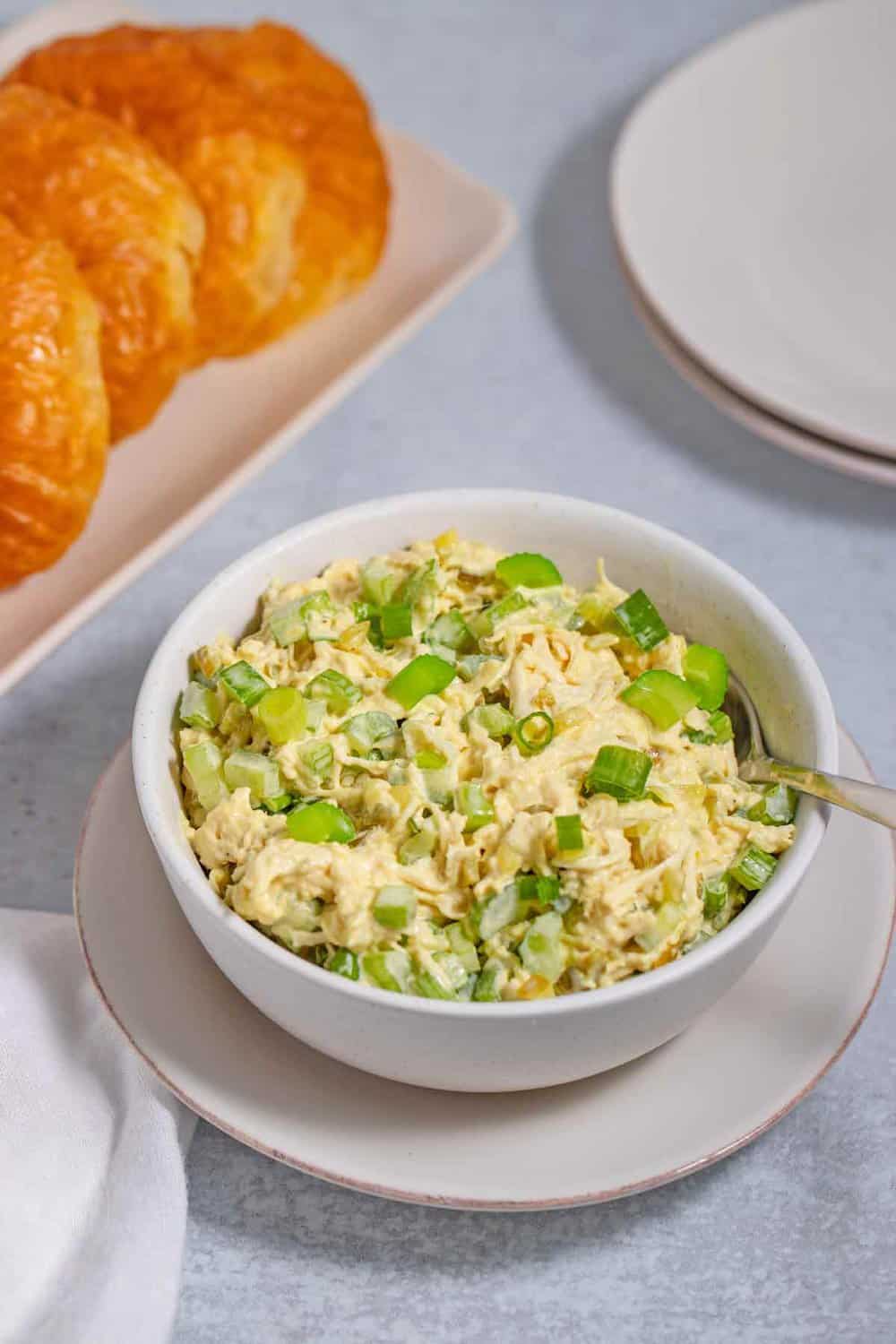
Wendy Dwyer
Thanks for all this research. Just did first time appreciate especially info pectin in skins and save the water making soup with it.
Beverly
My brother volunteers at a food kitchen where they serve food to people who are hungry but may not have any funds to buy food. They have a rack with donated food, free for anyone. One organization donates bags of dry foods including garbanzo beans, lentils, and green split peas. Some people here are not familiar with these three types of beans so they do not take them from the rack. I am hoping to come up with some recipes using these beans but cooking them in a way that is familiar to them so they will take advantage of this great nutrition.
I received quite the education from reading your tips on cooking garbanzos! I will also see if you have tips about cooking the other ones. Thank you so much for sharing your knowledge.
Owen
Good work! Definitive. I'll follow your advice. Thanks.
JoEllen
Hi Tami,
OMG, thank you so much for your thoroughness with the methods you used to determine the different ways for soaking and cooking garbanzo beans. You attention to detail is extremely helpful! I had actually chose 4 websites to research cooking methods and yours was the first one that I checked out. Score! It's so refreshing to find a cook that can actually explain, in detail, the best way to cook beans.
I haven't been having much luck cooking them because they would be too hard or too mushy. I do know that old dry beans will do that as well. My last batch of dried garbanzo beans (fresh from the store anyway) ended up being cooked (stovetop) for two hours and yet there were still (albeit a few) ones that were uncooked.
I'm going to try your "soaking/cooking in salt" method next time. I don't want to consume too much salt but I feel that if it helps to get a better consistency of cooked beans then it's totally worth it. I can omit salt from my diet in other ways. Again, I appreciate this write-up and will def be exploring your other cooking tips and tutorials.
Tami Mack @ The Tasty Tip
Thanks for your kind words. And good luck with your next batch of garbanzo beans.
Lee
After years of making lumpy hummus, I was excited to try this recipe because of the technique for removing the skins, but I must be doing something wrong. For me, the baking soda seems to be working *too* well. Not only does it break down the skins, it causes the beans themselves to fall apart. The skins and tiny bean bits are tangled together in sort of a lumpy sludge and there is no way to separate them. I tried rinsing off the cooked beans in a colander, but the pieces are small enough and soft enough that they pass right through the holes along with the skins.
Tami Mack @ The Tasty Tip
It sounds like the beans cooked too long. After soaking the beans in baking soda, they cook about 10-15 minutes faster. Then you may get peeling skins without the mushiness. However, if lumpy hummus is the problem, I recommend checking out my post on smooth creamy hummus. I make that recipe of hummus every single week. Good luck.